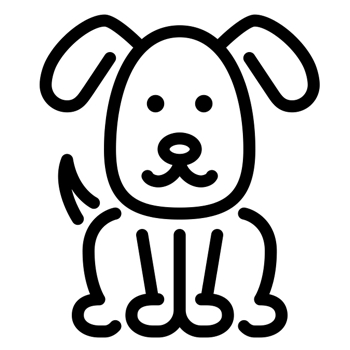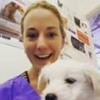Chonzer

The Chonzer is a classically cute dog that marries the reliable Schnauzer with the friendly Bichon Frise. As this dog has relatively low exercise requirements, can live in a small home and is generally hypoallergenic, they make excellent urban pets. Playful when younger and ever reliable, they are a good choice for family with children.
Chonzers are small, wiry dogs with stocky bodies and good-sized heads. They have attractive wavy or curled coats, which can be a number of colours, including the characteristic white of the Bichon Frise and the ‘salt and pepper’ greys of the Schnauzer. They usually have triangular-shaped ears, which fold forward sweetly.
About & History
Chonzer dogs have not been on the scene for long but their parents each have a substantial and well-documented history. Hybrid dogs have been a welcome addition to the canine community, offering owners more of a choice when picking a pet and avoiding the inbreeding that is involved with pedigree lines; which can lead to a population with more health issues.
The Schnauzer
Schnauzers are a hard-working German breed that would be kept by local farmers for a number of reasons, including to kill vermin, guard livestock and drive cattle. Given their working background, it makes sense that they are a high energy and determined breed and that they are easily trained. The Kennel Club classifies them within their Utility Group.
The Bichon Frise
The Bichon Frise is a curly-coated, white pedigree that is thought to have originated on the Spanish island of Tenerife over 500 years ago. Local sailors would sail with the dog on board and they were exported throughout Europe as the years went by.
They became especially popular in France, where their elegant looks were further refined. Mainly kept as a pet, the Bichon Frise also ‘turned its paw’ to some part time entertainment work and would be used to perform tricks as a form of amusement. Thanks to their gentle temperament and hypoallergenic coat, they are currently a very popular pet throughout the world.
Appearance
The small yet solid body of the Chonzer measures anything from 25cm to 40cm and they weigh in at between 11kg and 16kg.
Dogs typically inherit the circular skull of the Bichon Frise with ears that are widely spaced apart and should hang facing slightly out and forwards. They have circular brown eyes that are so dark they may appear black in certain lights. Their rectangular muzzle is more reminiscent of that of the Schnauzer and should not be snubbed or under-sized. Their limbs are straight and strong, while their paws are rather slender and delicate. Their tail is usually medium in length and may curl somewhat at the end.
A Chonzer’s fur has a nice curl to it and is quite dense. Potential coat colours include black, white, grey and brown and most dogs will have several tones to their fur. Longer fur is generally seen around the eyebrow, moustache and beard areas.
Character & Temperament
Happy-go-lucky, calm and kind, the Chonzer was made to be a family pet and enjoys being in the company of people of all ages. Seemingly always in a good mood, they are eager beavers when it comes to going out on walks and partaking in games. Most will tolerate children and other pets, especially if raised with them from puppyhood.
One potential issue that can develop in some individuals is separation anxiety, which can prove difficult to resolve once established. Owners should work on their confidence and make sure they are used to being left alone for short periods from when they are young. Crate training is a sensible strategy to employ and should be started as soon as the pup is brought home. The crate should be seen as a sanctuary rather than somewhere to go as punishment or ‘time out’.
Trainability
Descended from two clever dogs who have traditionally been taught to carry out a range of tasks, the Chonzer makes an agreeable training partner. These dogs have a desire to please so will follow instruction as long as they are given clear training cues and are rewarded for the correct behaviour. Despite their small size, anecdotally it is not especially difficult to house train this cross breed.
Health
Owners should watch out for the following health conditions within the Chonzer breed:
Atopic Dermatitis
There are several reasons that a dog can become itchy and owners should not always jump to the conclusion of allergies. However, if we rule out parasites and contact reactions (to things such as cleaning fluids or nettles), atopy is quite likely in this breed. For most, their symptoms will develop between the ages of 6 months and 6 years and can include paw licking and face rubbing.
Cushing’s Disease
Cushing’s Disease is also known as hyperadrenocorticism and the symptoms can include excessive thirst, a pot belly, chronic skin infections and panting. It can be slightly tricky to diagnose but blood tests can help confirm a clinician’s suspicions. Often, an abdominal ultrasound will be undertaken to check for a tumour on the adrenal glands.
Type 2 Diabetes
Those with diabetes will have elevated blood sugar levels, which can be detected on both a blood test and a urine test. Symptoms of diabetes include excessive thirst, an insatiable hunger and weight loss. Those with diabetes are especially prone to urinary tract infections as the bacteria thrive on the sugar. As well as modifying their diet, most dogs will be started on injectable insulin.
Urinary Stones
Stones within the kidneys and/or bladder typically cause issues with urination, such as straining or blood in the urine. Frustratingly, analysing urine does not always tell us if stones are present or, if they are, which type they are. Some will dissolve after changing the dog’s diet, while others may need to be surgically removed.
Exercise and Activity Levels
One hour of exercise each day will be plenty for the Chonzer. Owners should make an effort to vary where they walk their dog and to allow plenty of exploring and sniffing. Those with reliable recall should be allowed off lead if they can be trusted. Many will be keen to meet other dogs and ‘make friends’ when out and about.
Grooming
These dogs do not shed much fur and only need to be brushed a couple of times a week. Owners must pay particular attention to the areas where fur is longer such as on the face and tail. Claw clipping is a good skill to master, though many dogs will keep their claws short if walked on pavement frequently enough.

